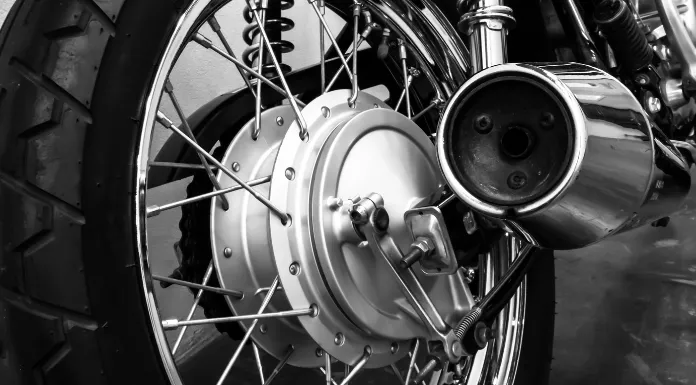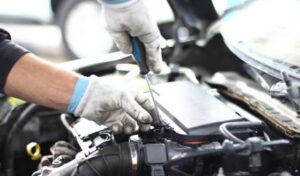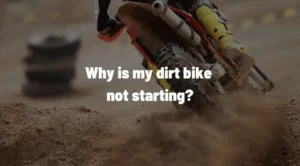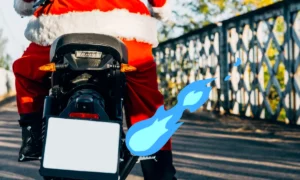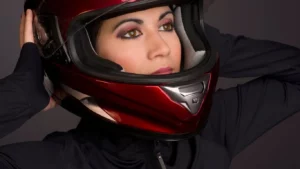If you find that your motorcycle won’t start but the engine is cranking, then you really need to follow the steps in this post because I have already gone through them myself and found the solution.
Because of this reason, I have created a list of 14 possible factors that may be the reason why your motorcycle would not start.
When your motorcycle doesn’t start, it’s not always easy to determine what the issue is, and you can not assume what the problem is because it can be many things.
But instead of calling a mechanic at the first sign of a problem, there are steps for what to do when your motorcycle won’t start.
First, ensure the battery works. Then, you can use easy explanations to inspect and fix your bike yourself.
How to Tell Whether Your Motorcycle Battery is Good
It’s possible that this is the reason, or at least one of the reasons, why your motorcycle chugs.
You’re not sure if your motorcycle’s battery is good. If it’s not obvious when you turn the key, you may need to check the battery.
Dim running lights, a clicking sound when you turn the key, and a short-lived starter crank are symptoms of a dead battery.
If none of these signs convince you or you’re unsure what to look for, check the battery’s voltage.
Visually inspect, verify the voltage, and load-test your battery to validate its health.
A visual battery inspection involves:
- Checking for a broken terminal
- Examining the battery for leaks/checking for any errant fluid
- Looking for bumps or cracks on the battery case.
- If everything is ok, then check the voltage.
The reading of the voltage should stay in the range of 9.5 to 10.5 for around thirty seconds. If the data does not change, this indicates that the battery is in good shape; however, there is probably an issue with another component of your motorcycle.
In light of the fact that you have determined that the battery is fine, the question now is: what else possibly be wrong with your motorcycle?
When it comes down to it, there could be any number of problems with your motorcycle, but the fact of the matter is that it just won’t start.
When it comes to finding a solution to the problem, there are a number of indicators, or signs and symptoms, that can take you in the right path.
There is a good chance that the problem lies within one of these three categories: fuel, compression, or spark. In order to get the bike going, you need to figure out which of those is falling behind and how to get it back on track.
Why is My Motorcycle is Cranking But Not Starting?
- No gas in the tank
- Clutch switch has been damaged
- Motorcycle is not in the right gear
- Loosed wires somewhere
- Kill Switch is Off
- Fuel valve is not set
- Fuel Injection System Issue
- Damaged Spark Plugs
- Clogged Petcock
- Blown Fuse
- Damage in Vacuum Line
- Muffler is dirty
- The choke is not properly checked
- Past Maintenance
Here are the explanations of the things to check to get your motorcycle up and running again:
1. Confirm if There’s Gas in the Tank
Checking to see if there is gas in the tank is a fundamental part of the pre-trip inspection process; however, riders frequently neglect to perform this check.
If you know for sure that your motorcycle has gas in the tank, check to see if the fuel pump is working properly.
Additionally, if your motorcycle has a carburetor, check to see if there is gas getting into that as well.
2. Clutch switch has been damaged
Even when in neutral, the clutch needs to be engaged in order for certain motorcycles to start.
There is also the possibility that the clutch switch on your motorcycle has become damaged; in this case, you can try to “push” the clutch a few times to see if that helps reset it.
It is possible to get past the clutch switch, but in the long run, you will have to replace the clutch.
3. Motorcycle is not in the right gear
To start the engine, it is possible that in addition to depressing the clutch pedal, you will also need to ensure that the transmission is in the neutral position.
If you are unfamiliar with the bike that is giving you issue, shifting the bike into neutral and engaging the clutch might be an important checking step that can spare you from a possible source of frustration.
4. Loosed wires somewhere
Checking the electrical connectors to ensure that everything is properly plugged in is yet another thing to do. Electrical problems aren’t always evident to riders, so electrical difficulties frequently go undetected.
However, carefully examining the connectors can help you find a fault that wouldn’t otherwise present itself.
5. Kill Switch is Off
There are some riders who don’t make regular use of their kill switch, but if you have used it in the recent past, there’s a chance that the engine cutoff switch is still on.
Either that or someone else flicked it, or you did it by accident – either way, it’s worth giving it a brief glance, as the switch lingering in the on position will prevent the motorcycle from starting.
6. Fuel valve is not set
If your motorcycle has fuel valves, having them adjusted in the incorrect position can prevent the machine from starting.
Make sure the fuel valve is in the “on” position, and then wait patiently for the float bowls of the carburetor to fill up. This should only take a few seconds.
7. Fuel Injection System Issue
Because fuel injection systems can be difficult to work with, it might be difficult to tell whether the injectors on your motorcycle are malfunctioning or whether another issue is to blame.
Since fuel injectors don’t break down very often, experts think it’s more likely that a pump will break down.
8. Damaged Spark Plugs
Another simple potential repair that may be done to motorcycles that are unable to start when they have been tried.
The failure of spark plugs can lead to a loss of power, poor gas mileage, engine misfiring, difficulties starting the engine, and a slow throttle. The engine may also be difficult to start, which is another sign.
In addition, as part of the regular preventive maintenance you do on your motorcycle, you should check the spark plugs. Your motorcycle will continue to retain its value and remain in good shape as a result of your doing this maintenance.
9. Clogged Petcock
One of the many things that could make your motorcycle not start is a clogged petcock.
A fuel control valve is indicated by the petcock. It has settings for off, on, and reserve, which allow it to control the flow of gas.
Riders often complain in online forums about how hard it is to open the petcock.
10. Blown Fuse
Like cars and trucks, motorcycles have fuses, and those fuses are just as likely to blow as the ones in cars and trucks.
It is helpful to keep a fuse kit on hand so that you may replace any blown fuses with a new fuse that has the same amperage as the previous one.
11. Damage in Vacuum Line
It is also possible for the line that connects the petcock to the engine to get damaged, which prevents the system from functioning as it should.
In the event that the line springs a leak as a result of cracking, rot, or road damage, you will either be able to reseal it or be required to replace it.
12. Dirty Muffler
It’s possible that something got stuck in your muffler. This is especially typical if the bicycle has been kept outside for an extended period of time or if it has been stored for some time.
In addition, if the muffler is obstructed in any way, the dirt bike might not start.
13. Choke is not Properly not Checked
If your motorcycle has a carburetor, the temperature of the engine will determine whether you should adjust the choke or the mixture enricher.
Another error that occurs frequently is that this problem might arise when the weather is particularly severe or when the conditions take a sudden change that you hadn’t anticipated.
14. Past Maintenance on the Motorcycle
Think back to the last time you maintained your motorcycle, regardless of whether you recently rode it or whether it’s been sitting in storage for a few months.
It’s possible that the problem was caused by cleaning your bike, which led to water getting into places where it shouldn’t have been.
Look for cracks or other openings through which water might have entered your bike, as well as for places where it might have caused damage to the electrical systems, knobs, buttons, or other components.
Assumption can be extremely risky and expensive, and there are actions that can be taken to find out what is wrong with your motorcycle.
Don’t overlook the Simple Things
The methods on the list are easy to follow and will help you determine whether or not your bike is in good working condition.
Riders frequently neglect to pay attention to what should be the motorcycle’s most fundamental component.
Before you start removing and cleaning parts or getting tools involved in the repair, it’s best to start with the simplest way possible to figure out what the issue is first. This will save you a lot of headaches.
Do not rush to replace parts of your motorcycle simply because you believe it will not start unless you are very certain what the problem is and how to fix it.
Conclusion
It’s as easy as crossing a few items off your pre-trip list to ensure that your motorcycle starts up on the first try every time. Before you can get back on the road, there are some situations in which you will need to seek the assistance of a professional in order to perform a comprehensive overhaul.
Nevertheless, doing these steps will provide you with a foundation upon which to build your investigation into the nature of the problem and your subsequent efforts to fix it.
